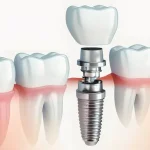There are many causes of tooth loss in adults. Beyond the practical and functional implications, the loss of a tooth can have a profound impact on an individual’s self-esteem and emotional well-being. Many patients tell us that they don’t even dare to smile anymore!
Fortunately, there are various solutions for replacing a missing tooth, including installing dental implants.
In this article, we’ll go over the steps that make up the standard procedure for installing a dental implant.
What is a dental implant?
Simply put, a dental implant is an artificial root that is inserted into the jawbone. Once this root is in place, the surgeon can attach a replacement tooth to it, similar to a crown. The procedure makes it possible to replace a missing tooth and fill the gap. You can learn more about dental implants by consulting our article on the topic.
Even if it’s possible to live with a missing tooth, remember that the Canadian Dental Association recommends filling a dental gap as soon as possible to maintain good oral health. In fact, a missing tooth can increase your risk of developing tooth decay, loose teeth, dental misalignment and gum problems.
Now that you know a bit about dental implants, let’s delve deeper into how they are installed.
How to install dental implants: a step-by-step procedure
The procedure for installing a dental implant successfully usually requires several appointments with your surgeon. Most implant procedures involve the following 5 steps:
Complete oral exam
Your dental surgeon needs a thorough understanding of your general oral health so they can provide the best possible treatment. At your first appointment, they will carry out a comprehensive oral exam.
This allows us to make an initial assessment and anticipate any possible complications. We’ll do everything we can to make sure the dental plant procedure goes smoothly. It is also an opportunity to get to know each other, review your medical history, and answer any questions you may have.
During your first visit, we will take a 3D X-ray of your oral cavity to verify that the bone volume of your jaw is sufficient to accommodate the dental implant. If this is not the case, it will be necessary to perform a bone graft before installing the implant.
Installing the implant
The next step involves actually installing the implant. This part of the procedure is usually performed under local anesthesia, but in some situations, it may be preferable to use conscious or intravenous sedation.
Once the anesthesia has taken effect, your maxillofacial surgeon will begin by making an incision in your gum to reach the bone of your jaw. They will then create a space for your implant and insert it into the bone. Last, the surgeon will suture your gum to allow it to heal.
Healing and integration
The recovery period is a very important stage of dental implant installation. During this phase, the jawbone heals and fuses with the implant. The term used to describe this process is osseointegration.
The integration period usually lasts from 2 to 4 months. It is a key part of the procedure, during which the bone regenerates and develops a strong bond with the titanium surface of the implant. At this stage, the patient is responsible for maintaining good oral habits and carefully following postoperative instructions.
Installation of dental prosthesis
You’ve reached the final step in the dental implant procedure: installing the dental prosthesis.
Once your bone has properly fused with the implant and your gums have healed, your dentist can create and attach the final artificial replacement tooth.
This process demands a high level of precision and may require several appointments before a perfect fit is achieved. Fine-tuning is key to the success of the procedure and will allow you to enjoy all the benefits of your dental implant.

Post-operative follow-up
It’s important to take care of dental implants the same way you take care of your natural teeth. Good dental hygiene will have an impact on how long your dental implant will last. Remember to brush your teeth at least twice a day, floss, and schedule regular visits to your dentist for check-ups.
The better you take care of your dental hygiene, the more you will gain from investing in dental implants.
If you are worried about the dental implant procedure …
We are used to helping our patients with their dental implant procedure. It’s normal to have worries and ask questions. Choosing the right surgeon can go a long way toward making your experience comfortable and successful.
If you are in the Montreal area and you are looking for a maxillofacial clinic that you can trust, know that our experienced surgeons perform many different procedures, including the installation of dental implants.
You can also keep reading for answers to a few common questions patients often ask before their operation. Feel free to contact us with any concerns not listed below!
How long does the dental implant process take?
The time it takes to install dental implants depends on several factors:
- The number of implants
- The complexity of the procedure
- The patient’s oral health and whether a bone graft is required
The initial consultation usually lasts between 30 minutes and 1 hour. Further examinations may be required to plan the full treatment.
Dental implantation surgery takes about thirty minutes for a single implant, and between one hour and 90 minutes to install several implants on the same arch. Again, this can vary depending on the complexity of the operation.
Does dental implant surgery hurt?
You won’t feel any pain once the local anesthesia is administered. Once the anesthesia wears off, it is normal to have sensitivity at the surgical site, but dental implant surgery is not known to be painful.
Any discomfort is usually easily controlled using specially prescribed painkillers.




